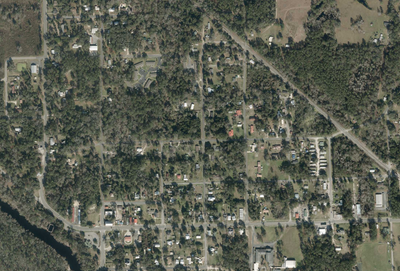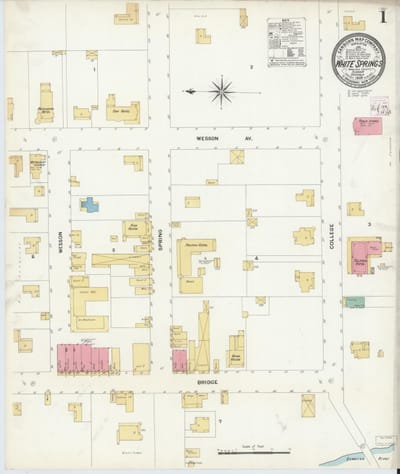History of White Springs


People visited and lived around the sulphur springs on the north bank of the Suwannee River for centuries before the Town of White Springs incorporated in 1885. Paleoindians were likely the first to discover the springs, although local legend holds that the native Timucuans were the first to recognize the medicinal value of the spring's sulphur water. They considered the area surrounding the spring to be sacred and the sick and infirm from all tribes were permitted to frequent the springs undisturbed. The Suwannee river gets its name from the Timucuan word that means "crooked black river".
While the Seminoles who later settled in the area probably shared the native's reverence of the spring, it was first capitalized in 1835 by Bryant Sheffield, who purchased about 300 acres on the Suwannee River that included the 56 acre spring tract around the second-magnitude springs. After discovering that he "felt better" while bathing in and drinking the spring's constant 72-degree mineral waters, he built a log hotel and encouraged his friends from Georgia and the Carolinas to come enjoy the healing waters.
In keeping with the long history of regard for the springs, the settlement around the springs sheltered displaced families during the Civil War. With families from Florida's coastal areas evacuating to the hotels and safe houses near the spring, the small river community became known as the "Rebels Refuge."
As the town grew and rail tourists frequented the spa village, grand hotels and resorts eventually occupied more than two-thirds of the original Sheffield plantation tract. With popular tunes like Stephen Foster's "Old Folks at Home" sweeping the country in 1851, the quaint timber town "Way Down upon the Suwannee River" continued to welcome more and more visitors each year.
Bustles, Buggies, and Boardwalks
By the 1880s, Florida's timber boom had arrived, cotton was king, and the local economy was good. Florida's first tourist destination boasted more than 500 hotel and boarding house rooms, river boardwalks, two moving-picture shows, a roller rink, and an elaborate, multi-level spring house enjoyed by thousands of visitors each year. Wealthy travelers were pampered at luxury hotels like the Hamilton, the Colonial and the Edgewood while they bathed in the spring, drank its medicinal waters, and were treated to massage and other spa treatments.
Business travelers stayed in the dozens of boarding houses or smaller hotels in town such as the Mattair House, Horn House, or the High House. African Americans who took advantage of the weekend rail excursions for picnicking and other recreational opportunities stayed at Nodia McClary's or King Henry Williams' Boarding Houses, or took rooms with the Noah Bennett family and other local residents.
In the evenings, residents and visitors retired to cool shady front porches to watch the passing tourists strolling on the boardwalks, shopping for the latest fashions, or on their way to one of the Season's Grand Balls. A steady stream of buggies and carriages brought visitors down Spring Street to the various hotels and guesthouses with the train stopping in town four times a day by 1909.
The Fire
On February 24, 1911, a fire started in the Baptist parsonage, the home of the Reverend Wambolt, and quickly spread through the town's business district. Many of the men in town were out hunting, and many buildings were saved were due to the heroic efforts of members of the town's African American community and neighbors who banded together. Thirty-five structures were destroyed including the Harris' Livery, the Oate's Millinery Shop; and the Oaks, High, and Paxton Hotels.
A Foster Memorial
In 1931, Josiah K. Lilly, an Indianapolis drug manufacturer and collector of Foster memorabilia, suggested that the State of Florida should honor the memory of Stephen Foster, the composer whose song "Old Folks at Home" made the Suwannee River famous world-wide.
The Florida Federation of Music Clubs selected the Town of White Springs as the site of the proposed memorial after the town and the Saunders family donated riverfront land in the resort, high on a flood-proof bluff. In 1935, the Florida Legislature adopted "Old Folks at Home" as Florida's official song; and in 1939, the state provided a primary appropriation of $25,000 and established a Commission to begin the development of a Stephen Foster Memorial. With the completion of the Stephen Foster Museum, the park officially opened in 1950.
Just three years later, Florida folk culture became a permanent component of the Center when the All Florida Folk Festival began. In 1957, the Carillon Tower was built, housing the world's largest set of tubular bells. Today the music of America's favorite songwriter and the folk arts of Florida are alive at the Stephen Foster Center as the bells peal out Foster melodies over the Crafts Square.
The park's campground also hosts outdoor enthusiasts who enjoy exploring the Florida Trail, as well as other biking, hiking and canoe trails through the park grounds that connect to other public lands.
Florida's Folk Festival
The Florida Folk Festival - the oldest state folk festival in the country - began in 1953. The White Springs event celebrates Florida's cultural diversity and provides a venue for the nation's most talented musicians, songwriters and artists. Floridians of all ages and backgrounds share their tales and traditions. Regular performers refer to the Folk Festival at White Springs as a Homecoming where stories are traded, and late night jam sessions lead to new songs and acts.
Nationally recognized performers featured at the festival have included Bo Diddley, Bill Monroe, Vassar Clements and John Anderson. The prestigious Folk Heritage Awards are presented each year at the Folk Festival along with the highly competitive Florida Fiddlers Championship.
Eco-Tourism Hub
The town's future as an eco-tourism center began with the formation of the Suwannee Bicycle Association and the River Road Canoe Outfitters in 1977.
Once again the town welcomed strangers, this time dressed in cycling suits topped off with helmets or sporting day-glow flotation devices.
Local motorists became accustomed to streams of cyclists on town streets and scenic country roads leading to the public lands surrounding White Springs. Phosphate lakes just north of town became nationally recognized for their trophy-sized bass. While fishing and hunting stories are still the mainstay, "river levels" have also worked their way into local conversations as the whitewater rapids of the Suwannee's Big Shoals challenge more and more kayakers and canoeists. Campers, hikers, and equestrians discovered the natural attributes of the Suwannee River Valley.
Historic Designation
In 1994, a group of White Springs natives and new "homefolks" formed the White Springs Historic Preservation Society to cultivate interest in the town's cultural history. The fledgling group solicited support from local governments, businesses, and the Florida Division of Historical Resources to conduct a historic resource survey of the town. A historic district containing 110 significant structures was listed in the National Register of Historic Places in 1997. The Society continues to celebrate the town's remarkable history and to preserve the unique natural and cultural heritage of the region.